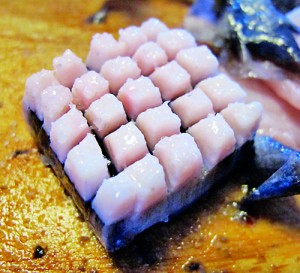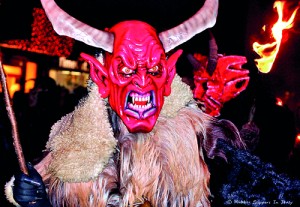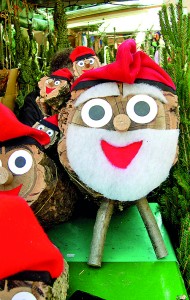Sunday Times 2
Deep-fried caterpillars, ‘hide the pickle’ and the legend of the bloodthirsty Yule Cat
If you thought that hiding a lucky coin in a pudding or sticking a Christingle orange with sweets and a candle were weird, think again.
In addition the concept of an overweight elderly man breaking into millions of homes in one night, each country has a host of strange and wonderful traditions that have built up around the humble nativity story.

Greenland has some unusual Christmas recipes; tucking into Mattak (raw whale skin, served with blubber) (© CC BY-SA 2.0 'The coders way of cutting mattak'by Risager)
An investigation by LoveHomeSwap.com has unearthed some of the best, and worst of Christmas traditions from around the world, some of which involve a rather less jolly version of Santa Claus.
In Austria, children live in fear of Krampus, a Christmas devil who’s said to beat naughty children with branches, while the Greeks believe that the Kallikantzaroi, a race of evil goblins, lurk underground. During the 12 days of Christmas they supposedly surface, wreaking havoc.
Equally distressingly, South African children are told the story of Danny, a young boy who angered his grandmother by eating the cookies that had been left for Santa. In her rage she killed him, and he is said to haunt homes at Christmas.
In Iceland the Yule Cat is said to stalk the Icelandic hills and those who don’t receive new clothes before Christmas Eve are said to be devoured by this mythical beast.
Catalonians include the figure of the Caganer in their nativity scenes – a small figure of a defecating man.
Though many in the UK spend the run up to Christmas frantically preparing for family and guests to descend, in Norway there’s no cleaning on Christmas Eve – all brooms are safely hidden away, in case they’re stolen by witches and evil spirits.

In Austria, children live in fear of Krampus, a Christmas devil who's said to beat naughty children with branches (©CC BY-ND 2.0 'Red-faced Krampus' by Rubber Slippers In Italy)
However, not all traditions have such a sinister edge to them, with many being either bizarre or heart-warming, demonstrating how Christmas can bring communities together.
Charmingly, Canada Post recognises the address Santa Claus, North Pole, Canada, HOHOHO and any letters received bearing this address are both opened and replied to.
Many Venezuelans attend Mass in the run-up to Christmas. However, Caracas residents have developed a strange tradition – journeying to Mass on roller skates.
As well as stockings, German children leave a shoe outside the house on December 5th, which is then filled with sweets overnight. Naughty children awake to find a tree branch in the shoe instead.

On Christmas Day, South Africans tuck into the deep-fried caterpillars of the Emperor Moth (© CC BY-SA 2.0 'Fried caterpillar and dragonfly' by KentWang)
Germans also traditionally hide a pickle in the Christmas tree on Christmas Eve – the first child to discover it in the morning receives a small gift.
Ukrainians forego tinsel and baubles, instead decorating their Christmas trees with an artificial spider and web.
Every December, Cuban city Remedios plays host to the Parrandas festival. The city divides into two halves, each building a themed sculpture from light bulbs, in preparation for Christmas Eve.
Catalonians have the Tió de Nadal, otherwise known as the ‘pooping log’. Decorated

Catalonians have the Tio de Nadal, otherwise known as the 'pooping log'. Decorated with a face and blanket, on Christmas Eve the log is placed halfway into a fire and beaten with sticks (© CC BY-SA 2.0 '| Tió |' by arquera)
with a face and blanket, on Christmas Eve the log is placed halfway into a fire and beaten with sticks.
Each neighbourhood in Guatemala creates a large pile of dirt made from the sweepings from each house, before placing an effigy of the devil on top, and burning it.
In the Czech Republic, unmarried women stand by a door and throw a shoe over their shoulder – if the toe is pointing towards the door when it lands, they will get married within the next year.
While in Latvia, a group of ‘mummers’, dressed in a variety of costumes, travel from house to house. Each household must give them a treat in return for a blessing.
And of course, food plays a central role in festive celebrations around the world, but some countries shun the traditional turkey and stuffing for some rather more exotic fare.
On Christmas Day, South Africans tuck into the deep-fried caterpillars of the Emperor Moth.
Greenland also has some unusual Christmas recipes, tucking into Mattak (raw whale skin, served with blubber), and Kiviak (500 dead auk birds, stuffed into a seal skin, and left to ferment for seven months).
Makes you rather grateful for that dry-as-a-bone turkey…
© Daily Mail, London

